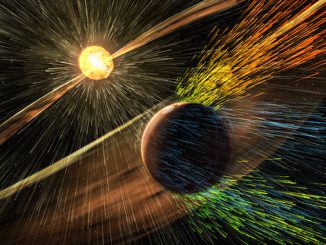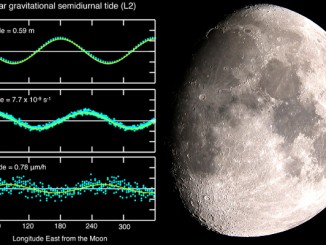
atmosphere


Pluto’s “Twilight Zone” reveals its secrets
NASA’s New Horizons spacecraft took this stunning image mere minutes after closest approach on 14 July 2015. Seen here, sunlight filters through and illuminates Pluto’s complex atmospheric haze layers over portions of the nitrogen ice plains informally named Sputnik Planum, as well as mountains of the informally named Norgay Montes.

VLA radio map reveals what lies deep below Jupiter’s visible clouds
Observations with the National Science Foundation’s Very Large Array (VLA) have given astronomers an unprecedented look into the atmosphere of Jupiter. The scientists used the VLA to study the dynamics of Jupiter’s atmosphere from the visible cloud surfaces down to about 60 miles (100 kilometres) below the clouds.

Pluto’s blue atmospheric ring in the infrared
A new image from NASA’s New Horizons spacecraft is the first look at Pluto’s atmosphere in infrared wavelengths, and the first image of the atmosphere made with data from the probe’s LEISA instrument. The blue ring around Pluto is caused by sunlight scattered from a haze of hydrocarbon particles in the form of a photochemical smog.

Phase of the Moon affects amount of rainfall
When the Moon is high in the sky, it produces bulges in the Earth’s atmosphere that create measurable changes in the amount of rain that falls below, according to new research. But no-one should carry an umbrella just because the Moon is rising — even in the tropics, average rainfall rates are only increased by 1/10,000 of an inch per hour.

Pluto’s haze in bands of blue
This processed image is the highest-resolution colour look yet at the haze layers in Pluto’s atmosphere. Shown in approximate true colour, the picture was constructed from a mosaic of four panchromatic images from the Long Range Reconnaissance Imager (LORRI) splashed with Ralph/Multispectral Visible Imaging Camera (MVIC) four-colour filter data, all acquired by NASA’s New Horizons spacecraft on 14 July 2015.

What happened to early Mars’ atmosphere?
Scientists may be closer to solving the mystery of how Mars changed from a world with surface water billions of years ago to the arid Red Planet of today. A new analysis of the largest known deposit of carbonate minerals on Mars suggests that the original Martian atmosphere may have already lost most of its carbon dioxide by the era of valley network formation.


